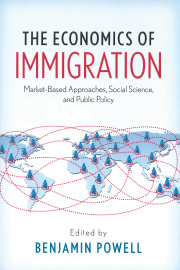Consideration of the “gang of eight” proposal in the U.S. Senate has rekindled the national discussion about immigration reform and it’s high time that this discussion emphasizes a thorough understanding of the economic case for free trade in labor.
A cursory understanding of recent history demonstrates that relatively free trade has lifted great masses of people out of poverty worldwide. The United States boasts a long record of relatively free trade and has always benefited from being essentially one big “free trade zone” internally. Goods and services, capital, and labor all move without governmental restriction throughout the nearly four million square miles of the United States.
Interference with the free flow of trade has always occurred along the arbitrary lines politicians have drawn on the map. During the 19th century, tariffs and other barriers restricted international trade in goods and services. However, for the most part, labor was free to enter or leave the United States. Following World War I, the federal government enacted a series of laws restricting immigration. The interwar years also witnessed significant restrictions on trade in goods and services.
Trade barriers for goods and services have fallen considerably since the establishment of general agreement on tariffs and trade (GATT) in 1947. Support for free trade in goods and services commands more consent among economists than virtually any other issue. In fact, free trade has been a core issue for economists ever since Adam Smith’s 1776 publication of An Inquiry into the Nature and Causes of the Wealth of Nations.
The basic case for free trade builds upon the fact that different people, in different places, have different abilities to produce goods and services. If governments allow them to trade freely, market forces will naturally push each person (and country) to produce those goods and services that they can produce at the lowest cost and import those goods and services that they could only produce at greater expense. As a result, market exchange creates a greater amount of total wealth than would occur in the absence of such exchange.
Substitute labor mobility for the mobility of goods and services and the process works in a very similar fashion. Given their abilities, interests and costs, each laborer moves to where they can create relatively more value for others. If capital, natural resources, and goods and services, were all perfectly mobile labor mobility wouldn’t be as economically important as it is.
Unfortunately, some governmental barriers to trade in goods and capital flows remain, some services must be provided in-person, and, by definition, many natural resources are in a fixed position. Thus, labor mobility remains crucial for our prosperity. In fact, increasing labor mobility greatly dwarfs the gains that could be achieved through further removal barriers to capital flows and trade in goods and services.
Economist Michael Clemens has documented that completely eliminating world-wide barriers to immigration would result in net gains of $30 to $90 trillion for the world economy (50 to 150 percent of world GDP). On the same token, removing the remaining barriers to capital flows and trade would only add a few percentage points to world GDP. Even a smaller migration of five percent of people from poorer parts to wealthier parts of the world would exceed the wealth gains that could be had by eliminating remaining trade and capital flow barriers.
Internally, the United States harnesses market forces to determine optimal interstate migration. I recently moved from Massachusetts to Texas. I weighed the value I could create in Texas (measured by the salary I was offered) against the value I could create in Massachusetts, while also considering cost of living differences and other factors. Market forces dictated that I could, on net, create more value in Texas. No government planning or quota system was necessary to make this determination.
Market forces are necessary to coordinate the international labor market as well. Increasing the number of H-1B visa’s or temporary work permits is a small step in the right direction but governments can no better plan the international labor market than the Soviets could plan their markets.
People are, of course, different than goods and services because they can influence politics or use existing public policy to transfer resources away from others and to themselves. These issues are beyond the scope of the basic economic case for immigration, but I believe, as Independent Institute Senior Fellow and author Alvaro Vargas Llosa suggests in his new book, Global Crossings: Immigration, Civilization, and America, are largely problems of existing interventionist public policy rather than problems of immigrants themselves.
Conservatives who support free trade in goods and services, but oppose greater migration, and liberals who support immigration but oppose free trade, both need to understand that the economic case for free trade in both labor and in goods and services is essentially the same. Freeing markets in both areas will make the world, and the United States, wealthier.











